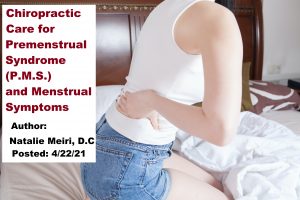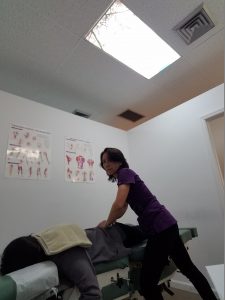
Premenstrual syndrome (P.M.S.) is a hormone mediated response to fluctuating levels of progesterone and estrogen (sex and reproductive hormones). Symptoms generally represent the consequences of emotionaI lability (rapid, often exaggerated changes in mood, where strong emotions or feelings occur). For instance, mood swings, anxiety, and depression occur. Furthermore, hormonal effects on neuroendocrine (cells that release hormones into the blood in response to stimulation of the nervous system) function cause headaches, food cravings, fluid retention, breast tenderness or fullness, and back pain. P.M.S. appears 7 to 10 days prior to menses and improves within hours to days following the onset of menses. After that, dysmenorrhea (menstrual symptoms) may appear.
Dysmenorrhea is the medical term for pain with your period (menstruation) or menstrual cramps. There are two types of dysmenorrhea: primary and secondary. Primary dysmenorrhea is the name for common menstrual cramps that come back over and over again (recurrent). Secondary dysmenorrhea can be due to other diseases. With secondary dysmenorrhea (due to endometriosis or fibroids), you may want to talk to your doctor (OB/GYN) about a diagnosis and treatment options.
More than half of women who menstruate have some pain for 1 to 2 days each month. Usually, the pain is mild. Others have severe pain with other symptoms, including diarrhea, nausea, vomiting, headache, and dizziness. Above all, it keeps them from doing normal activities for several days a month.
Why Do P.M.S. (Premenstrual Symptoms) and dysmenorrhea occur?
The pituitary gland, a pea-sized gland at the base of the brain, produces a number of hormones. Each of these hormones affects a specific part of the body. Luteinizing hormone and follicle-stimulating hormone produced by the pituitary, promote ovulation and stimulate the ovaries to produce estrogen and progesterone.
Estrogen and progesterone stimulate the uterus and breasts to prepare for possible fertilization. Estrogen causes the breast ducts to enlarge. Progesterone production causes the milk glands to swell. Both of these events can cause your breasts to feel sore.
Before a period begins, the cells that form the lining of the uterus begin to break down. As a result, large amounts of inflammatory prostaglandins are released. During menstruation these chemicals constrict the blood vessels in the uterus and make the muscle layer contract, causing painful cramps. Additionally, prostaglandins can cause symptoms of headache, nausea, vomiting, diarrhea, and urinary frequency. Heavy contractions can lead to low back pain. Similarly, lower abdominal pain can radiate into the low back.
Theories to explain why symptoms vary from woman to woman:
-Some women may metabolize progesterone differently with the result of less allopregnenolone. (Allopregnanolone is a neuroactive steroid involved in modulating behavioral functions, stress)
-Serotonin levels decreasing. Serotonin is a key hormone that stabilizes our mood, feelings of well-being, and happiness.
-There is estrogen excess or progesterone deficiency (through stimulation of the renin-angiotensin system and increased levels of aldosterone) leads to fluid retention. The Renin-Angiotensin-Aldosterone System (RAAS) is a hormone system within the body that is essential for the regulation of blood pressure and fluid balance.
-There are nutritional imbalances in B6 and magnesium, altered blood sugar levels, and prostaglandin imbalance.

Meiri Chiropractic Can Provide Chiropractic Care for Premenstrual Syndrome (PMS) and Menstrual Symptoms
Relieve and manage your PMS and menstrual symptoms naturally with chiropractic care. After all, pain medications can be harmful and additive. In regards to Chiropractic spinal manipulation studies, most have tested the treatment effect for dysmenorrhea and some studies have indicated manipulation has a positive effect on PMS. The following is recommended along with adjustments:
–Exercise may help decrease the frequency or intensity of PMS symptoms.
–Stop smoking.
–Diet. Recommendations for diet modifications include:
-eat small, regular meals
-follow a low-fat or vegetarian diet; limit red meats, dairy products, foods with a high sugar content, and fried foods
-limit or eliminate caffeine and alcohol
-increase dietary fiber and water (increase to six to eight glasses/day for natural diuresis)
–Get enough sleep/relax
Seek the help of an experienced West Palm Beach chiropractor to ensure you get the best Chiropractic Care for Premenstrual Syndrome (PMS) and Menstrual Symptoms. Visit your West Palm Beach chiropractor today to learn about other things you can do to keep your body healthy, or get treatment for acute or chronic pain!
References
Walsh MJ, Polus BI. A randomized, placebo-controlled
clinical trial 011 the efficacy of chiropractic therapy on premenstrual
syndrome. J Manipulative Pbysiol Tbe1c 1999;
22:582-585.
Oyelowo TA. Diagnosis and management of premenstrual
syndrome in the chiropractic office. Top Clin Cbiro.
1997;4:60-67.
Liebl NA, Butler LM. A chiropractic approach to the treatment
of dysmenorrhea. ] lvIrtnipulative Pbysiol Ther.
1990;13:101-106.
Meiri Chiropractic
561-253-8984